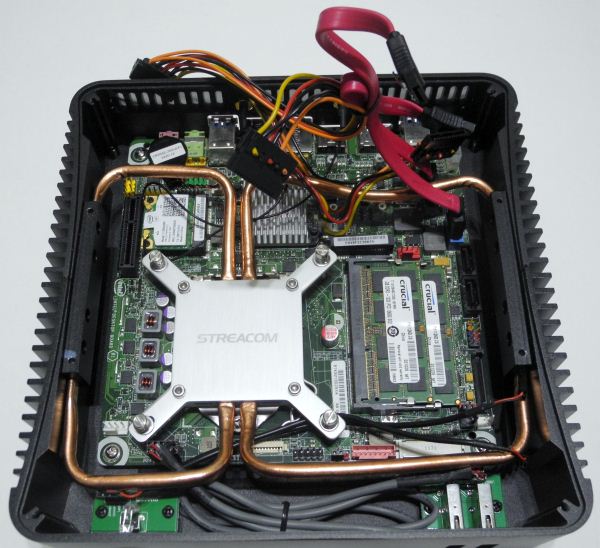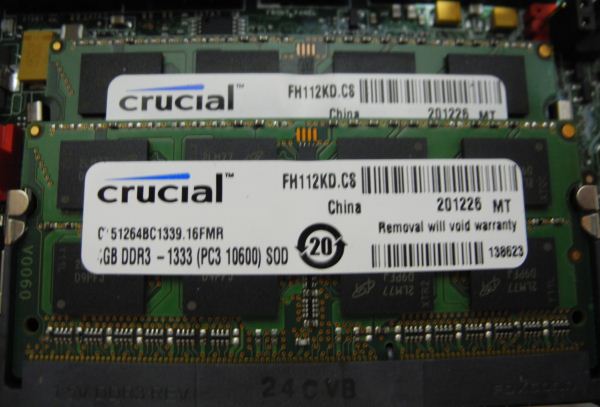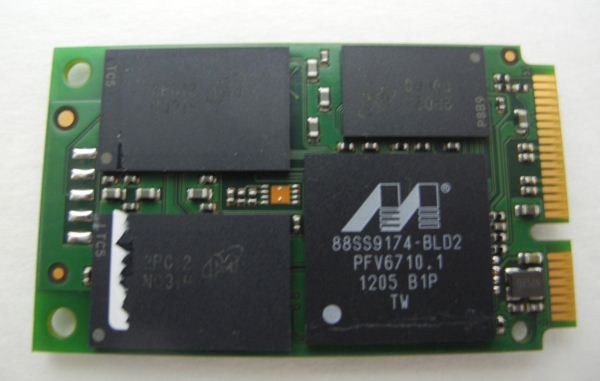Aleutia Relia Industrial PC Review: Ivy Bridge & Q77 in a Fanless Chassis
by Ganesh T S on December 4, 2012 10:00 AM EST- Posted in
- Industrial PC
- HTPC
- Ivy Bridge
- Aleutia
System Teardown and Analysis:
The Aleutia Relia's most interesting aspect is the passive cooling. In order to understand the thermal solution and also take a look at the internal components, we disassembled the system. It was quite easy to take apart, with the top being held in place by four screws. Of particular interest is the thin gauzelike fabric pasted around the ventilation slots on the top panel (and also present beneath all the other ventilation slots). This makes the unit dust-resistant. Since there are no moving parts to move the dust inwards, this porous gauzelike material is capable of shutting out most of the dust. Of course, it doesn't make it dust proof, but offers an added layer of protection. Beneath the top panel, we have a bar with two hard disks fastened on to it. The bar itself is fastened to the side panels using four screws. Beneath this disk assembly, we have the main board and the passive cooling solution. The gallery below presents some of the teardown pictures
Motherboard & Chipset : mITX DQ77KB with Q77 Express
The Aleutia Relia is based on the Intel DQ77KB motherboard which contains the Q77 Express chipset. This mini-ITX board supports direct 19 V DC input (no need for a PSU -- except for the AC - DC adapter). It has two SO-DIMM sockets, four USB 3.0 ports, eight USB 2.0 ports and five SATA ports (2 x SATA 6 Gbps, 2 x SATA 3 Gbps, 1 x mSATA). The mSATA port is a full mini-PCIe card slot. In addition, the board also has a half-mini card slot taken up by the WLAN solution and an empty PCIe 3.0 x4 add-in card slot (unusable in the Relia).
The board also has the Realtek ALC892 audio codec along with two GbE ports.
CPU & GPU : Intel Core i7-3770T / Intel HD Graphics 4000
The Core i7-3770T is a 4C/8T processor belonging to the Ivy Bridge family. It has a TDP of 45 W. Clocking in at 2.5 GHz, it is capable of going up to 3.7 GHz in Turbo Mode. 8 MB of L3 cache is shared between the integrated GPU (HD4000) and the CPU cores. The GPU runs at 650 MHz, but, can turbo up to 1.15 GHz under certain conditions. It supports full 3D video capabilities, QuickSync v2.0 and WiDi. However, WiDi isn't supported by the DQ77KB as it is an unnecessary feature in the target market.
DRAM: Crucial 2 x 4GB DDR3-1333
The Aleutia Relia uses two Crucial CT51264BC1339 4 GB SODIMM kits. It has a CAS latency of 9-9-9-24.
Considering that the Relia has a 3rd generation Core processor in the i7-3770T, we expected Aleutia to go in for DRAM rated at 1600 MHz.
Storage Drives : Crucial CT128M4SSD3 128 GB mSATA SSD / 2 x 500 GB Western Digital Scorpio Black WD5000BPKT
The unit uses a 128 GB Crucial mSATA SSD as the primary drive and two 2.5" 500 GB Western Digital hard disks as secondary drives. The review unit had the two hard drives configured as separate drives. However, it is possible to set up the BIOS to put them in RAID-0 or RAID-1 depending on the requirements.
The Scorpio Black drives operate at 7200 rpm and has a 16 MB cache. The Black series has a warranty period of 5 years. It is generally regarded as one of the highest performing 2.5" hard drives in the market. The primary drive (Crucial mSATA SSD) is much more interesting. Unlike the Phison based mSATA SSD we saw in the Zotac ZBOX Nano XS, this one has bona fide credentials and has very good performance comparable to the SATA SSDs. It has NAND from Micron and the controller is the Marvell 88SS9174.
This Marvell controller is also present in the Intel SSD 510, the Corsair P3 series and the Crucial m4 SATA SSDs.
WLAN : Intel WiFi Link 1000
Aleutia has gone in for a 1T2R single band (2.4 GHz) WiFi solution for the Relia. The Intel WiFi Link 1000 is a low profile single side design. It is 802.11 b/g/Draft-N compatible. The version present in the Relia is in a mini-PCIe card form factor. In order to increase range, the unit has two antenna slots at the rear of the unit. Two TP-Link antennae are also supplied.
Considering that the unit has two GbE ports and can act as a firewall, some use cases could involve making the WLAN solution act as a Wi-Fi access point. In this case, it is disappointing to find that the solution is single- band and has only 1T2R instead of the usual 2T2R solutions seen in other pre-built mITX PCs such as the ASRock Vision HT.





















47 Comments
View All Comments
ganeshts - Wednesday, December 5, 2012 - link
Nope, we could clearly hear the noise from the hard drives.deltaTdawg - Wednesday, December 5, 2012 - link
This article makes it clear that the author has very little experience reviewing fanless systems.From an engineering perspective, there are 3 elements of interest in the thermal system - the CPU block, the heatpipes, and the heatsinks.
1. The author never looked at the thermal block, never took it off, never examined the thermal paste, never checked how flat or smooth the block surface was. Flatness and roughness play a HUGE role in cooling. Most importantly, thin metal mounting systems tend to flex when overtightened. This leads to a bowing of the CPU block, causing very poor contact with the CPU.
2. These heatpipes are 6mm diameter. Heatpipes have thin walls, so if they are bent too tight they can crimp and severely impact the flow of evaporated fluid which actually dissipates the heat. Look at the gallery. See the heatpipes? In the 5th image especially it is clear how many bends and crimps exist. Each crimped point severely impacts cooling performance. To examine this, the author could use an IR thermometer to look at the heatpipe temperature before and after each crimp. The flaws would be immediately evident as the heatpipe would be significantly lower temperature after each crimp. This indicates the heat is not dissipating properly.
3. Simple: Finned heatsinks are not ideal for convection cooling. Also, the mounting bracket does not apply even pressure, and no effort is made to distribute the heatpipe condenser evenly over the heatsink surface.
From an engineering standpoint, this is a disaster. My conclusions are supported by the experimental findings in this review. A cooling system that causes an ULV CPU to throttle. Hmm. I have personal experience with completely passive systems that can easily cool a i7-3770K under full CPU+GPU load - under 80C.
ganeshts - Wednesday, December 5, 2012 - link
The point of the review's thermal performance section was to present to readers whether / how much the CPU gets throttled under different ambient temperatures and not meant to go into a thesis on how Aleutia could improve the thermal performance.Anyways, responding to your points:
This is a loaner sample and meant to get back to the manufacturer in working condition. Not all systems that reach our labs can be subject to full teardowns. So, even assuming that I took out the thermal block and judged the smoothness of the block surface, those stats matter zilch to the reader once the thermal performance stats (how long it takes for the system to get throttled under load) is presented. FWIW, the loading process was repeated countless times before the system made it to the temperature chamber. In effect, taking out the thermal block and analyzing it would have probably made sense in a dedicated review of the Streacom cooling solution and not for the Relia itself.
Btw, the i7-3770T is NOT officially a ULV CPU. It is just power optimized and operates at lower base clocks (2.5 GHz) instead of the default i7-3770 (3.4 GHz) to bring down the TDP from 77 W to 45 W.
We would like to definitely hear about the components used in your passively cooled system. What is the size of the system, and how long does it operate at max performance without throttling and at what ambient temperature?
deltaTdawg - Wednesday, December 5, 2012 - link
Fair enough.I didn't mean to come off aggressively, and I apologize if I did. Certainly there is a limit to what testing can be performed. The reason the cooling system matters, in my mind, is because it is performing so poorly. SPCR reviewed a unit from the OEM chassis provider - Streacom FC5 OD - using a 65W i3-2100 processor. In that review, the system didn't throttle; rather, it hit 74C (53C above ambient) on full CPU+GPU load. This is not terrific performance - but it is much better than the Aleutia system.
So from that I can only conclude that Aleutia's particular design is what has negatively affected results - which is why I feel it is of interest for this review, not for a Streacom review. In my mind, a system whose cooling system can't handle a burn-in load is not fit to ship. Most vendors do a burn-in/stress test prior to shipping, to ensure the system components are not faulty. Aleutia obviously wasn't able to do this; so how can they ensure the components are stable? From an industrial market perspective, stability and performance in a hot environment should be the utmost concern.
My system is 13"x10"x5" (WxDxH). It is running a Gigabyte GA-Z77N-WIFI, an i5-3750K, 8Gb DDR3 1600MHz, and a 128GB Intel 520. It is using a custom chassis and custom cooling system, and has zero moving parts. Ambient is 18C. The system idles at 31C, and full CPU+GPU load stabilizes at 56C. Return to idle temps when the load is removed occurs in under 30 minutes.
The system runs overclocked at 4.1GHz. Idles at 37C, full GPU+CPU load at 78C, which stabilized after 45 minutes and stayed stable thereafter. Return to idle temps occurs in under 30 minutes.
Overclocking is limited by the motherboard's lack of voltage control. The hardware maintains stable temperatures around 80C at 4.3GHz - but the system is not stable. I will be testing next with the Asus P8Z77i motherboard, which is overclocker friendly.
One last question: Why did you unlink the gallery? And why, if you find the gallery link (http://www.anandtech.com/Gallery/Album/2429) did you remove all the inside photos? This seems to come right on the heels of my remarks on their cooling system.
ganeshts - Wednesday, December 5, 2012 - link
The Streacom FC5 OD is a uATX chassis while this one is mITX. I guess the larger surface area of the FC5 OD will definitely contribute to better cooling.Streacom is planning to introduce a modified version of this chassis in the market as the FC2 (with an open backplate, obviously). I am looking forward to someone making a better performing system with the FC2 (not that I am defending Aleutia here, but I just want to see how much of the issue is with Streacom rather than Aleutia).
Your system definitely sounds interesting and I am sure readers would appreciate some pictures of the internals to understand how to design their own passively cooled systems.
Btw, the gallery is still there in the piece and was never 'unlinked'. The URL you are referring to:
http://www.anandtech.com/Gallery/Album/2429 : This is from the previous pipeline piece where I covered the launch of the Relia.
The inside photos are in this gallery:
http://www.anandtech.com/Gallery/Album/2473
deltaTdawg - Wednesday, December 5, 2012 - link
Yeah, sorry about that. That's what happens when you sit down at the computer before you have your morning coffee :)Interestingly, the chassis dimensions are not really relevant. What actually matters for heat dissipation is the heat sink surface area. I can't account for the size of the fins, but the mounted surface area on the two systems is virtually identical, as the FC5 uses only one heatsink to dissipate, whereas this unit uses both. The FC5 heatsink spans 30.2 square inches, while the Relia spans 31 square inches.
I would love to show off my system. However, it's a near-launch unreleased product, so I can't share photos online yet. I'll email you separately, if you're interested. Suffice to say, silent cooling like I've described is challenging, if not impossible, to achieve with consumer parts. But it's a real passion for me, so I'd be happy to continue the conversation by email.
ganeshts - Wednesday, December 5, 2012 - link
Sure, feel free to send over the details to my e-mail ID (can be got from the author by-line). I can keep it under wraps till launch.zilexa - Wednesday, December 5, 2012 - link
Seriously?? Who the HELL is going to spend >600 on this device?People who do that clearly do not have a clue what to do with their money.. *sigh*
I love the fact it uses mSATA and has enough options to connect. But as HTPC, just buy a Zotac AD12 or AD06 or similar and you are done (preferrably the AMD option since they support out-of-order execution and feel faster then the Atoms, and have better graphics built in).
There is absolutely no use for a Core i7 in a HTPC. It doesn't have a dedicated GPU so it is also not meant for gaming. This thing is really to shake money out of peoples pocket.
ganeshts - Wednesday, December 5, 2012 - link
Hmm.. This is an 'enterprise' play. You pay for quality and support too.I can't find any other pre-built PC with similar configuration for a lower price (read, fanless mITX with dual GbE and i7- class processor). People looking for industrial PCs will know the value :)
Btw, usage as a HTPC is just an additional application. There are use-cases such as hotel room TVs and signage applications where reliability is key and the benchmarks I have presented in the review are helpful.
Would I recommend this for the standard living room HTPC? Probably not.. The target market, as I explained in the final section, is something different.
Sikku - Wednesday, December 5, 2012 - link
Does this system use a PicoPSU??Would like to see reviews of this type of PSU...